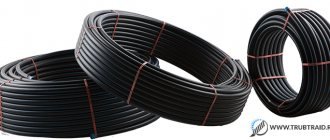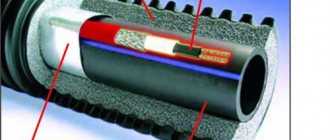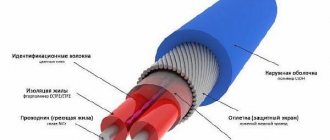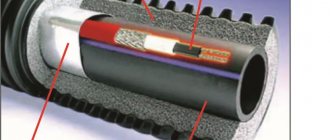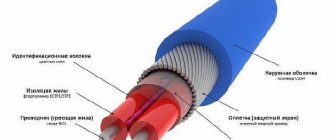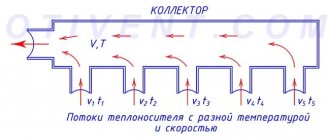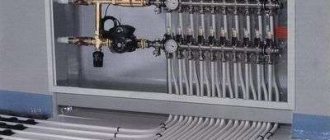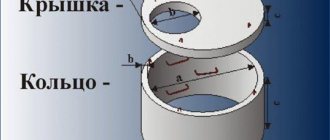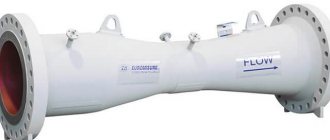The popularity of self-regulating heating cables is increasing both in industry and in households. They are especially indispensable in the fight against icing. When cold weather sets in, there is a risk of freezing and rupture of water or sewer pipelines, and the appearance of an ice crust on steps or paths.
In the article we will talk about the characteristics and types of self-regulating heating cable, the areas of its application, how installation is carried out on pipes and on the roof.
What is a self-regulating heating cable?
A self-regulating cable is the same electrical conductor, but an improved model. Its structure is more complex than a regular wire.
The heating control cable is a polymer matrix, with its help, under the influence of external temperatures, the resistance changes, according to the amount of heat it emits.
The heating element is two tinned copper wires, which are coated with a graphite plastic compound with the addition of a semiconductor polymer. This creates a self-regulating matrix that short-circuits the copper conductors.
The heating element is insulated with fluoropolymer thermoplastic, which also protects it from moisture. Next comes a shielded copper braid, it protects against mechanical stress and acts as grounding.
The outer shell is made of various materials. Each type is designed for specific operating conditions. Under standard conditions - polyolefin plastic, if the environment is aggressive - fluoropolymer.
The matrix and wire sheath are processed by radiation cross-linking.
Sokol-Electro ENGKEH-1-1.97/220-49.2
Photo: https://market.yandex.ru
The model can withstand temperatures up to 180 °C. The fully sealed sheath and explosion-proof design guarantee stable operation of the cable in any conditions. When purchasing, the future owner has the opportunity to choose the voltage - 220 or 380 volts. The minimum bending radius is 20 mm, the standard length of low temperature copper leads is 1000 mm. The stranded core is made of nichrome and braided with fiberglass. Installation does not require special skills or tools. Still don’t know which brand of heating cable for plumbing is better? Then pay attention to this product.
Heating cable SOKOL-ELECTRO
Advantages:
- quick installation
- tightness
- explosion resistance
- presence of protective braiding
Flaws:
- short length
Principle of operation
The principle of operation of a self-regulating conductor is the movement of electricity along the heating cores. As a result, there is an increase in temperature, and therefore resistance.
The higher the resistance, the lower the current and power. Conversely, the lower the temperature, the more heat is released.
Let's look at the operating principle of the cable:
- Self-regulating matrix - a large number of resistances, which are connected in parallel between the heating conductors, heat up when voltage is applied. This leads to expansion of the material, which breaks contacts between conductive particles, thereby reducing the amount of current supplied and heat transfer.
- When the temperature level of the heated area changes, the resistance of the matrix changes and the amount of heat that the heater gives off changes.
xLayder 40R-85
Photo: https://market.yandex.ru
In the production of reinforced concrete structures, xLayder sections are attached to the reinforcement, which eliminates the possibility of accidental displacement, although the cable is, in principle, resistant to mechanical damage and completely sealed. The connection is made on one side. No additional power cable is required for installation. The length of the bay is 85 meters. Heating power - 40 W. Stable performance indicators eliminate the possibility of boiling and burnout of wires. Uniform heating guarantees rapid hardening of concrete even at low temperatures.
Resistive heating cable xLayder 40R-85 85 m
Advantages:
- high strength
- quick installation
- uniform heating
- shielding
- long length
Flaws:
- heavy
Types - device, technical characteristics
Heating cables are divided into the following types: resistive, self-regulating, inductive.
They differ in operating principle, technical characteristics and design.
Resistive
Resistive cables come in linear and zonal types. For its effective operation, special equipment is required that will control the conductor, focusing on the ambient temperature.
The advantage of this type is low cost, reliability, ease of installation.
It should be said that such a conductor always releases the same amount of heat, regardless of the temperature of the air masses, so the consumption of electrical energy is low - which is not economically profitable.
Resistive is divided into:
- Linear - a wire whose ends are connected to the electrical supply. According to the number of current-carrying wires - single-core and double-core.
Single-core - consists of one heating core, usually a steel core, it is covered with an insulating layer of heat-resistant material that does not deform when heated. The wire comes with a screen to remove interference that is created by the cable itself and all kinds of protective devices.
The advantage of the single-core model is ease of use. The disadvantage is that it is not possible to cut to the desired size, the need to connect both ends in one place.
Twin-core - consists of two parallel conductors that transmit electric current. Their difference and advantage from the single-core type is that the second end does not need to be returned to the connection point, this is especially convenient when heating long pipelines.
- Zonal - its design is more complex compared to linear. It consists of two current-carrying copper wires, each of which has separate insulation. In addition, it is thicker than linear.
The difference between this type is that the internal insulation is equipped with windows every 1 - 2 meters. Through them, the conductor is connected to the heating wire, taking over the network voltage.
Thanks to this design feature, constant resistance is not present in the entire conductor, but only in one or another section-zone. The advantage is the ability to select the length of the section according to your needs. The downside is the high price.
The resistive heating conductor has a warranty period of up to 15 years, and when poured into a concrete screed, up to 50 years.
Self-regulating
A self-regulating heating cable is a modern model that differs from a resistive one not only in its design features, but also in its operating principle.
Self-regulating wires are conductors enclosed in a polymer matrix. A regulator is not required for operation; it will itself maintain the temperature at which it is set, so it will not overheat. This type is more expensive, but despite this, the increased efficiency makes it more economical.
In addition, it can be cut into pieces of any size. The guaranteed service life of this type is 10–15 years, but manufacturers include a reserve of up to 40%, which will significantly extend its operating time.
The self-regulating conductor can be shielded or unshielded:
- Shielded - the outer shell covers a braid of tinned copper wire, which protects against mechanical damage and serves as grounding. This cable is intended not only for heating the water supply, but also for installation outdoors - roofing, drainage.
The casing can be food grade - used for heating water supply and sewer systems inside, and with UV protection - mounted on the roof, where there is a lot of sunlight.
- Unshielded - the product does not have a protective shell. It is used for heating household pipelines; it is not installed outdoors, where exposure to aggressive environments is possible.
- Outer polyolefin sheath.
- Tinned copper wire braid.
- Elastomeric thermoplastic insulation.
- Polyester shell.
- Semiconductive self-regulating matrix.
- Copper conductors.
- Outer polyolefin sheath.
- Inner polyester shell.
- Semiconductive self-regulating matrix.
- Copper conductors
Shielded models are more expensive than those that do not have a shell.
The main areas of application of self-regulating heating cable:
- household pipes;
- icing systems (roofs, walkways);
- industry.
To heat various communications, a heating element of the following power is required. For:
- pipes inside - 10 W/m linear;
- pipeline outside - 15 W/m. P.;
- roofs and paths - 24-30 W/m.p.;
- anti-icing systems - up to 40.
Installation features
When laying a heating cable, it is important to follow a number of rules, namely:
- The ambient temperature at the stage of installation of the heating system should not be lower than +15ºС.
- Fixation on the surface should be done in such a way as not to damage the structural elements of the heating areas (factory fasteners, special tape, sealant, soft pads, clamps, etc.).
- When forming a route or grid, it is necessary to provide a sufficient heating area for a specific object, depending on its parameters.
- When turning, you need to ensure that the bend radius does not exceed six of its diameters.
- After installation is complete, be sure to check the integrity of the insulation and cores by testing and measuring the resistance level.
Now let's look at some practical tips regarding the specifics of laying in particular situations. If the heating cable is used to heat a roof or other objects where it is installed in direct sunlight, it is better to use shielded grades. Since braided models use a much more resistant sheath than general purpose cables.
When heating gutters, it is necessary to choose a location at the coldest point or on the least heated side. In horizontal troughs, the heating cable must be installed at the bottom of the trough so that the warm masses rise up and melt the ice higher up. In the vertical pipes of the drainage system on the side of the building wall, as shown in the figure, since it warms up the worst:
Rice. 6: Example of installation in a drainage system
Since the heating cable can be placed in water, it can directly heat water pipes or heating systems. Install it inside the pipe, as shown in the figure:
Rice. 7: example of laying a heating cable inside a pipe
It should be noted that it is prohibited to install a heating conductor inside sewer and waste pipes, as various debris will cling to it. Because of this, traffic jams will arise, worsening cross-country ability and leading to complete blocking. Therefore, polymer and metal sewer pipes are heated by installing heating elements on the outside. But it is worth noting that the heating wire must be insulated from the thermal insulation layer using a special aluminum tape.
Which type to choose
When choosing a self-regulating cable, you need to take into account the characteristics and parameters of the product, the principle of operation, its operating conditions - the length of the section required for heating, maximum low temperatures.
Points to pay attention to when purchasing a heating wire:
- the presence of a protective braid - it gives reliability and provides grounding;
- type of external insulation;
- product power.
Its choice also depends on the area of application of the heating conductor. If the wire is needed to heat the sewer system, then a polyolefin product is suitable; for plumbing systems, fluoroplastic protection is recommended.
For outdoor installation, it is better to take a model with fluoropolymer insulation; it protects from moisture and ultraviolet radiation.
If it is necessary to heat pipes with a small diameter, a low-temperature conductor with a voltage of 15 W/m is suitable. The purpose of medium temperature (up to 30 W) is a large diameter pipeline. Types with high voltage are practically not used in everyday life.
It is recommended to install a cable without a shield in pipes that are laid in the ground, since it is not equipped with a grounding braid. The shielded one is safer, but it costs more, and their heating matrix is the same, so there is no point in burying a more expensive model in the ground.
When buying a self-regulating heating heater, you need to squeeze it with your fingers, then move it along its entire length. In a low-quality product, air cavities will be felt inside.
Thermo SVK 20
Photo: https://market.yandex.ru
When wondering which brand of heating cable for water supply is better, you should pay attention to this product. The cable is laid in a screed with a thickness of 3 to 5 millimeters. Its main feature is its resistance to the most difficult operating conditions. The model is protected from moisture, freezing temperatures, ultraviolet rays, rapid wear and other factors. Power 165 W, core diameter 6.7 mm. To control the operation of the system, the owner can use a thermostat. The grounding conductor is made of tinned copper and does not oxidize during its entire service life. This guarantees a high level of electrical safety.
Heating cable Thermo SVK-20 500W
Advantages:
- durability
- convenient installation
- automatic operation
- shielding
- high power
Flaws:
- not detected
Areas of application
Self-regulating heating cable (Review and test)
The self-regulating heater is used both in everyday life and in industry. Its purpose is to heat domestic and industrial water pipes located both above and below the surface of the earth.
In the oil and gas industry, the product is used to maintain process temperatures.
Let us consider in more detail the most common areas of application of a self-regulating heating conductor in everyday life.
Warm floor
Samreg is used to install warm electric floors. When installing such a floor throughout the apartment, in the bathroom or toilet, the surface will warm up less. This is due to the fact that in other rooms there are usually other sources of heat, and the floor in the bathroom is made of tiles, which is a cold material.
If you use a resistive heating cable, then without installing additional equipment - a thermostat and sensor, you will not be able to achieve the desired balance.
The output is self-regulating; when installing it, there is no need for additional devices. The principle of operation is that the matrix itself will regulate the uniformity of floor heating.
Water pipes
To avoid freezing of water in pipes in winter, a self-regulating conductor is wrapped around the water supply valve. The valve has a complex shape, so the wire does not come into contact with every part of the metal.
When installing a resistive heating cable, it will heat more air. But if you install a self-regulating wire, the conductor will heat up only in those places where it comes into contact with the metal. After all, its operating principle is the efficiency of heat transfer.
Sewerage
Sewerage rarely freezes, since the pipes are located on a slope, the liquid in them does not stagnate, but leaks. However, if the drainage unit malfunctions, the water moves slowly and may freeze along the way. Ice layers will be layered on top of each other, eventually occupying the entire space.
The simplest option for heating the sewer system of a private house is to install a self-regulating heating wire, this will prevent the liquid in the pipes from freezing.
Roof heating
In winter, the roof is subject to icing, and it is difficult to determine which area will be susceptible to the formation of icicles. Using a heater with a semiconductor matrix will allow you to heat those areas of the roof where there is more ice and water.
You need to choose a type that is not exposed to ultraviolet rays and can withstand high temperatures, since in the summer the roof gets very hot.
Heating of greenhouses
The heating scheme for heating greenhouses using a heating cable is similar to underfloor heating. This is practically the same heating floor, only laid under a different coating.
The self-regulating cable is fixed to a protective mesh, which is located on a sand bed. The wire is covered with another layer of sand, then a second mesh is installed, on which the fertile layer is laid.
If the heating system cannot be installed underground, then a self-regulating heater is placed on the walls of the greenhouse.
SpyHeat SHFD-25-1000
Photo: https://market.yandex.ru
Shielding of the model provides protection from electromagnetic radiation. The fuel cores are covered with fluoroplastic insulation. They are reliable and resistant to local overheating. A fixed temperature thermostat simplifies outdoor use. The cable diameter is 8.5 mm, length - 40 meters. It is designed to operate from a household electrical network with a voltage of 220-240 V. The package includes all the necessary elements for self-installation and quick commissioning of the system.
Resistive heating cable SpyHeat SHFD-25-1000
Advantages:
- shielding
- extended equipment
- quick installation
- durability
- long length
Flaws:
- high power consumption
Rexant 15MSR-PB 2M
Photo: https://market.yandex.ru
The model is suitable for installation indoors or outdoors. Installation is carried out using fastening tape or by winding it onto a pipe in a spiral. The heating cable is connected to the supply cable, and at its reverse end there is a Euro plug that plugs into a grounded socket. Power - 30 W, cable thickness is 8.44 mm. The shell is resistant to abrasion and rapid wear. For safe use of the kit, the owner has the opportunity to connect it to a residual current device.
Self-regulating heating cable REXANT 15MSR-PB 2M
Advantages:
- easy installation
- high strength
- versatility
- shielding
Flaws:
- very short length
Samreg is divided according to the degree of explosion protection
- The explosion-proof self-regulating cable has an explosion protection certificate of the International Customs Union and an Ex (Explosion-proof) sign, which contains information about the degree and type of explosion protection of the cable. Explosion-proof cable is used in facilities with increased fire and explosion hazard. More details
- Without explosion protection, used in industrial and domestic heating systems that do not require increased explosion protection or fire safety measures.
Eastec SRL 10-2 CR
Photo: https://market.yandex.ru
Along with the cable, the package includes everything necessary for connecting to the electrical network: connection set, input coupling, power cord with plug. The food coating does not emit harmful substances, which guarantees safety of use in the water supply system. Cable power is 10 W, minimum bending radius is 25 mm. If necessary, the model can be easily divided into lengths from 20 to 120 centimeters. It features minimal energy consumption and is guaranteed to last more than 15 years.
EASTEC MICRO 10 – CTW, SRL 10-2CR M=10W, heating cable with food sheath
Advantages:
- convenient installation
- extended equipment
- high strength
- non-toxic materials
Flaws:
- low-power
#Top 10
Read us first - add the site to your favorite sources.
Add a comment
{"commentics_url":"\/\/express-novosti.ru\/comments\/","page_id":1103919,"enabled_country":false,"enabled_state":false,"state_id":0,"enabled_upload": false,"maximum_upload_amount":3,"maximum_upload_size":5,"maximum_upload_total":5,"securimage":true,"securimage_url":"\/\/express-novosti.ru\/comments\/3rdparty\/securimage\ /securimage_show.php?namespace=cmtx_1103919″,”lang_error_file_num”:”\u041c\u0430\u043a\u0441\u0438\u043c\u0443\u043c %d \u0444\u0430\u0439\u043b\u043e\ u0432\u043c\u043e\ u0436\u0435\u0442 \u0431\u044b\u0442\u044c \u0437\u0430\u0433\u0440\u0443\u0436\u0435\u043d\u043e.","lang_error_file_size":"\u041f\u043e \u0436\u0430\u043b\ u0443\u0439\u0441\u0442\u0430, \u0437\u0430\u0433\u0440\u0443\u0437\u0438\u0442\u0435 \u0444\u0430\u0439\u043b \u0440\u0430\ u0437\u043c\u0435\u0440\u043e \u043c \u043d\u0435 \u0431\u043e\u043b\u0435\u0435 %d MB.","lang_error_file_total":"\u041e\u0431\u0449\u0438\u0439 \u0440\u0430\u0437\u043 c\u0435\u0440\ u0432\u0441\u0435\u0445 \u0444\u0430\u0439\u043b\u043e\u0432 \u0434\u043e\u043b\u0436\u0435\u043d \u0431\u044b\u0442\u044c \ u043d\u0435\u0431\u043e\u043b\ u0435\u0435 %d MB.","lang_error_file_type":"\u041c\u043e\u0436\u043d\u043e \u0437\u0430\u0433\u0440\u0443\u0436\u0430\u0442\u044c \u0442\u0 43e\u043b\u044c ""lang_text_loading":" u0437\u043a\u0430 ..","lang_placeholder_state":"\u0420\u0435\u0433\u0438\u043e\u043d","lang_text_country_first":"\u0421\u043d\u0430\u0447\u0430\u043b\u0430 \u0432\u044b\u04 31\u0435 \u0440\u0438\u0442\u0435 \u0441\u0442\u0440\u0430\u043d\u0443″,”lang_button_submit”:”\u0414\u043e\u0431\u0430\u0432\u0438\u0442\u04 4c","lang_button_preview":" \u041f\u0440\u0435\u0434\u0432\u0430\u0440\u0438\u0442\u0435\u043b\u044c\u043d\u044b\u0439 \u043f\u0440\u043e\u0441\u043c\u 043e\u0442\u0440″,”lang_button_remove ":"\u0423\u0434\u0430\u043b\u0438\u0442\u044c","lang_button_processing":"\u041f\u043e\u0434\u043e\u0436\u0434\u0438\u0442\u0435..."}
Aura FS Inside 10-6
Photo: https://market.yandex.ru
The Aura FS Inside package includes a Euro plug and a universal coupling for quick connection and ease of insertion of the cable into the pipe. The shell is made of food-grade polymer - it does not emit toxic waste upon contact with liquids, which guarantees the safety of using water for any purpose. The length of the 60-watt cable is 6 meters. Modified polyolefin is used as core insulation. The kit is capable of stable operation in difficult conditions and can be mounted at subzero temperatures. The minimum bending radius of 15 mm allows the cable to be wrapped around very thin pipes.
Self-regulating heating cable AURA FS Inside 10-6
Advantages:
- protection class - IP68
- wear resistance
- quick installation
- durability
- versatility
Flaws:
- fragile shell
Depending on the maximum operating temperature, the samreg may be
- Low temperature (temperature class T6) – maximum exposure temperature 85°C, operating temperature 65°C;
- Medium temperature (temperature class T5) – maximum exposure temperature 135°C, operating temperature 110°C;
- Medium temperature (temperature class T4) – maximum exposure temperature 190-200°C, operating temperature 120°C;
- High temperature (temperature class T3) – maximum exposure temperature 232-250°C, operating temperature 190°C;
In domestic cable heating systems, as well as in roof heating systems, a low-temperature heating cable is used. Medium temperature heating cable is used in heating pipelines and tanks to support technological processes. High temperature heating cable is used in the oil and gas industry, usually for pipelines and tanks subject to high temperature steaming.
Main advantages of Samreg
- Not afraid of overheating in any individual area, blocking, even when crossing the cable;
- the self-regulation effect ensures a safe temperature regime for the object, which makes the system more reliable and durable;
- saving electricity by changing the linear power at each individual heating section;
- ease of installation, the cable can be cut into sections of any length directly at the installation site;
- Possibility of operation without thermostats and automation systems.
Structure of the heating cable
Self-regulation effect
View of the finished section
